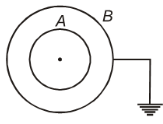An air capacitor of capacity \(C= 10~\mu\text{F}\) is connected to a constant voltage battery of \(12\) V. Now the space between the plates is filled with a liquid of dielectric constant \(5\). The charge that flows now from battery to the capacitor is:
1. \(120~\mu\text{C}\)
2. \(699~\mu\text{C}\)
3. \(480~\mu\text{C}\)
4. \(24~\mu\text{C}\)
1. \(120~\mu\text{C}\)
2. \(699~\mu\text{C}\)
3. \(480~\mu\text{C}\)
4. \(24~\mu\text{C}\)
Two identical metal plates are given charges respectively. If they are now brought close to form a parallel plate capacitor with capacitance , the potential difference between them is :
1.
2.
3.
4.
A and B are two concentric metallic shells. If A is positively charged and B is earthed, then electric:

1. field at the common centre is non-zero.
2. field outside B is non-zero.
3. potential outside B is positive.
4. potential at the common centre is positive.
Four equal charges \(Q\) are placed at the four corners of a square of each side \(a\). Work done in removing a charge \(-Q\) from its centre to infinity is:
1. \(0\)
2. \(\frac{\sqrt{2} Q^{2}}{4 \pi \varepsilon_{0} a}\)
3. \(\frac{\sqrt{2} Q^{2}}{\pi \varepsilon_{0} a}\)
4. \(\frac{Q^{2}}{2 \pi \varepsilon_{0} a}\)
An electron of mass m and charge e is accelerated from rest through a potential difference V in vacuum. The final speed of the electron will be
(1)
(2)
(3)
(4)
\((r>>2a)\) , where \(p = 2qa\))
| 1. | \(V={p\cos \theta \over 4 \pi \varepsilon_0r^2}\) | 2. | \(V={p\cos \theta \over 4 \pi \varepsilon_0r}\) |
| 3. | \(V={p\sin \theta \over 4 \pi \varepsilon_0r}\) | 4. | \(V={p\cos \theta \over 2 \pi \varepsilon_0r^2}\) |
Inside a hollow charged spherical conductor, the potential -
(1) Is constant
(2) Varies directly as the distance from the centre
(3) Varies inversely as the distance from the centre
(4) Varies inversely as the square of the distance from the centre
Two charged spheres of radii 10 cm and 15 cm are connected by a thin wire. No current will flow, if they have -
(1) The same charge on each
(2) The same potential
(3) The same energy
(4) The same field on their surfaces
Two spheres A and B of radius 4 cm and 6 cm are given charges of 80 μc and 40μc respectively. If they are connected by a fine wire, the amount of charge flowing from one to the other is -
(1) 20μc from A to B
(2) 16μc from A to B
(3) 32μc from B to A
(4) 32μc from A to B
On rotating a point charge having a charge q around a charge Q in a circle of radius r. The work done will be
(1)
(2)
(3) Zero
(4)






